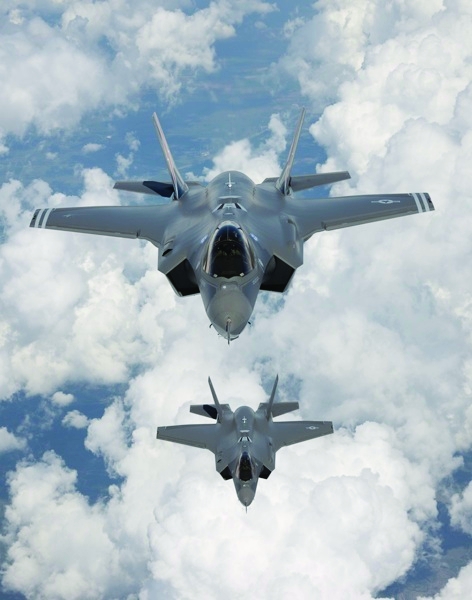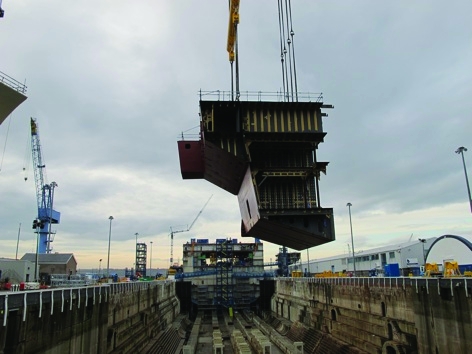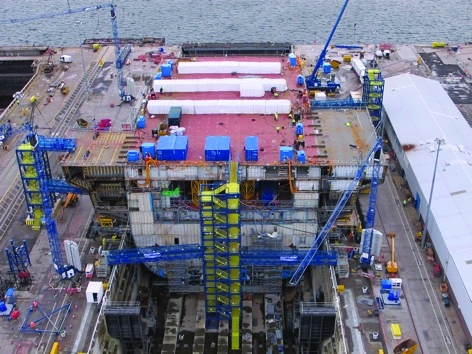In previous blogs I have written a lot about the Queen Elizabeth Class ships, but in terms of military capability, the aircraft carrier is only part of the equation. The aircraft and their weaponload that are deployed from the flight deck complete the picture. So, I thought I would talk a bit about the F35 Joint Strike Fighter. I recently visited the BAE Systems site at Samlesbury in Lancashire where the UK part of the F35 project team is based, and where the UK components of the aircraft are manufactured. The F35 is the latest generation of fast jets with extensive stealth features, and, like most modern fast jets, it is dynamically unstable. This means it needs complex software to make flying it possible, but it also gives it fantastic manoeuvrability.
There are three versions of the F35. The F35A is the land-based version, the F35B is the Short Take off and Vertical Landing (STOVL) version being developed primarily for the US Marine Corps. The third version -F35C – is the Aircraft Carrier variant that the UK is procuring. F35C aircraft have been successfully launched from land based catapults, both steam and electromagnetic, in the USA.

There are plans to manufacture some 3,000 aircraft, and the project is currently into low rate initial production while flight testing and certification of the aircraft takes place. The F35 is a multi-national enterprise with a significant UK content comprising the manufacture of the after fuselage and the vertical and horizontal tail surfaces, together with the design of some of the aircraft systems.
Meetings between the Aircraft Carrier Alliance and the F35 project team are very useful to ensure that both projects are kept up to speed with progress and that the all important interfaces between the ship and the aircraft are fully understood.
While at Samlesbury my colleagues and I were taken for a tour of the manufacturing facilities. We visited the machine shop where titanium material either as ingots or rough machined forgings enter at one end and leave the other as intricately machined piece parts ready to go onto the assembly line. The attention to detail in the geometry of the machined parts is remarkable. Any excess material that would add weight to the aircraft and thus reduce payload or performance is carefully machined away. However for me the most remarkable feature of the machine shop is that there was almost nobody there! The raw materials are loaded into a bank of machines where robots then take them and store them awaiting an available machine. Once a machine becomes available the robot takes the raw material and loads it into the machine together with the required tool for the job, and replaces the tools as they become worn which happens quite quickly when machining titanium. The tolerances that are being worked to are sufficiently close that the software controlling the cutters allows for the wear in the tool as it reaches the end of its life. The only apparent manual intervention was in loading the raw materials, cleaning and maintaining the machines and carrying out quality checks on the finished product.
Having seen the machine shop we then visited the assembly line. There are two parallel assembly lines, one for the after fuselage and the other for the tail surfaces. Like the machine shop they are kept to very high standards of cleanliness. On the assembly lines the components from the machine shop are located in jigs and all dry assembled before final machining. It was good to see some real people undertaking this work! At the end of the assembly line the carbon skins of the tail surfaces were being fitted to the framework before final quality checks. It was interesting to compare the manufacture of the aircraft tail surface with the manufacture of the ship’s rudders at Rosyth and the different challenges that the vastly different scales bring.
Meanwhile, back in the dry dock in Rosyth, HMS Queen Elizabeth continues to take shape. The centre blocks are all now loaded out and consolidated onto Lower Block 03 and the first three sponson blocks have also been added, so the full 70-metre beam of the ship can be seen.

In Portsmouth Lower Block 02 has now been painted in preparation for the passage to Rosyth in the spring, and as the scaffolding comes down the shape of the hull is being revealed. Standing by the forward end of the block and looking up at the hull flaring out above you is an impressive sight. At Birkenhead Cammell Laird have just moved Centre Block 02 out of the construction hall and into a completions facility where the compartment handover inspections will be carried out ready for its handover and transportation to Rosyth around May next year. As with the other blocks a very high degree of outfit has been completed within CB02 and Cammell Laird have done a very good job of the construction.

As the component parts of HMS Queen Elizabeth near completion in the various shipyards, work is getting underway on HMS Prince of Wales. The forward end is progressing well at Appledore, as is Lower Block 03 at Govan while the double bottoms for Lower Block 02 have started construction at Portsmouth.
2012 is already proving to be a hugely busy year for the Aircraft Carrier Alliance!











Water Sector Talent Exodus Could Cripple The Sector
Maybe if things are essential for the running of a country and we want to pay a fair price we should be running these utilities on a not for profit...